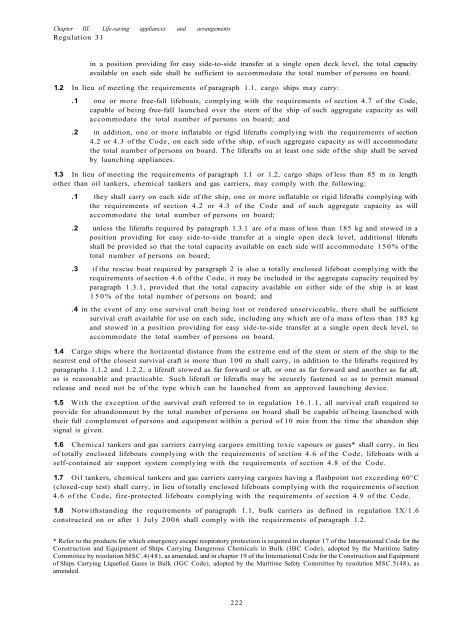Solas Consolidated Edition 2009.pdf
Solas Consolidated Edition 2009 for maritime
Solas Consolidated Edition 2009 for maritime
Create successful ePaper yourself
Turn your PDF publications into a flip-book with our unique Google optimized e-Paper software.
Chapter III: Life-saving appliances and arrangements<br />
Regulation 31<br />
in a position providing for easy side-to-side transfer at a single open deck level, the total capacity<br />
available on each side shall be sufficient to accommodate the total number of persons on board.<br />
1.2 In lieu of meeting the requirements of paragraph 1.1, cargo ships may carry:<br />
.1 one or more free-fall lifeboats, complying with the requirements of section 4.7 of the Code,<br />
capable of being free-fall launched over the stern of the ship of such aggregate capacity as will<br />
accommodate the total number of persons on board; and<br />
.2 in addition, one or more inflatable or rigid liferafts complying with the requirements of section<br />
4.2 or 4.3 of the Code, on each side of the ship, of such aggregate capacity as will accommodate<br />
the total number of persons on board. The liferafts on at least one side of the ship shall be served<br />
by launching appliances.<br />
1.3 In lieu of meeting the requirements of paragraph 1.1 or 1.2, cargo ships of less than 85 m in length<br />
other than oil tankers, chemical tankers and gas carriers, may comply with the following:<br />
.1 they shall carry on each side of the ship, one or more inflatable or rigid liferafts complying with<br />
the requirements of section 4.2 or 4.3 of the Code and of such aggregate capacity as will<br />
accommodate the total number of persons on board;<br />
.2 unless the liferafts required by paragraph 1.3.1 are of a mass of less than 185 kg and stowed in a<br />
position providing for easy side-to-side transfer at a single open deck level, additional liferafts<br />
shall be provided so that the total capacity available on each side will accommodate 150% of the<br />
total number of persons on board;<br />
.3 if the rescue boat required by paragraph 2 is also a totally enclosed lifeboat complying with the<br />
requirements of section 4.6 of the Code, it may be included in the aggregate capacity required by<br />
paragraph 1.3.1, provided that the total capacity available on either side of the ship is at least<br />
150% of the total number of persons on board; and<br />
.4 in the event of any one survival craft being lost or rendered unserviceable, there shall be sufficient<br />
survival craft available for use on each side, including any which are of a mass of less than 185 kg<br />
and stowed in a position providing for easy side-to-side transfer at a single open deck level, to<br />
accommodate the total number of persons on board.<br />
1.4 Cargo ships where the horizontal distance from the extreme end of the stem or stern of the ship to the<br />
nearest end of the closest survival craft is more than 100 m shall carry, in addition to the liferafts required by<br />
paragraphs 1.1.2 and 1.2.2, a liferaft stowed as far forward or aft, or one as far forward and another as far aft,<br />
as is reasonable and practicable. Such liferaft or liferafts may be securely fastened so as to permit manual<br />
release and need not be of the type which can be launched from an approved launching device.<br />
1.5 With the exception of the survival craft referred to in regulation 16.1.1, all survival craft required to<br />
provide for abandonment by the total number of persons on board shall be capable of being launched with<br />
their full complement of persons and equipment within a period of 10 min from the time the abandon ship<br />
signal is given.<br />
1.6 Chemical tankers and gas carriers carrying cargoes emitting toxic vapours or gases* shall carry, in lieu<br />
of totally enclosed lifeboats complying with the requirements of section 4.6 of the Code, lifeboats with a<br />
self-contained air support system complying with the requirements of section 4.8 of the Code.<br />
1.7 Oil tankers, chemical tankers and gas carriers carrying cargoes having a flashpoint not exceeding 60°C<br />
(closed-cup test) shall carry, in lieu of totally enclosed lifeboats complying with the requirements of section<br />
4.6 of the Code, fire-protected lifeboats complying with the requirements of section 4.9 of the Code.<br />
1.8 Notwithstanding the requirements of paragraph 1.1, bulk carriers as defined in regulation IX/1.6<br />
constructed on or after 1 July 2006 shall comply with the requirements of paragraph 1.2.<br />
* Refer to the products for which emergency escape respiratory protection is required in chapter 17 of the International Code for the<br />
Construction and Equipment of Ships Carrying Dangerous Chemicals in Bulk (IBC Code), adopted by the Maritime Safety<br />
Committee by resolution MSC.4(48), as amended, and in chapter 19 of the International Code for the Construction and Equipment<br />
of Ships Carrying Liquefied Gases in Bulk (IGC Code), adopted by the Maritime Safety Committee by resolution MSC.5(48), as<br />
amended.<br />
222


